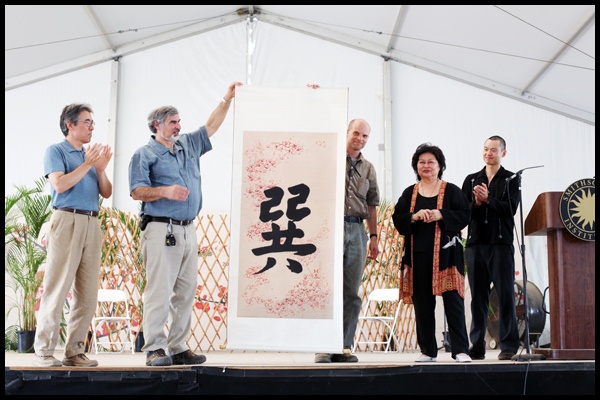Folklife Festival Recap
As the sun began to set in the west over the Washington Monument and as the Smithsonian Folklife Festival came to a close, Dr. Catherine Yi-yu Cho Woo—calligrapher, painter, and feng shui master—tells the tale of Cao Cao’s defeat at the Yangtze River from Chinese epic work, The Romance of the Three Kingdoms, how a fortunate east wind saved the southern armies of Sun Quan and Liu Bei from impending invasion.

With such an allusion to the Chinese proverb, “all that is needed is an east wind,” Dr. Woo gifted to the Smithsonian a scroll commemorating the historic Asian Pacific Americans Folklife program. The scroll contains the character 巽, the trigram for “wind,” (from 易經, The Classic of Changes), symbolizing the wish for the East Wind 東風 of fortune to bless the Smithsonian in its future projects.
But the East Wind is only a beginning; without the strategic mind of Zhuge Liang to take advantage of the winds, Cao Cao’s forces may very well have defeated Sun Quan and Liu Bei. Likewise, the Festival programs were only breezes of a beginning for understanding local communities with global connections. The Festival’s APA Programs Curator Phil Nash emphasizes the need to build upon the connections made at the Festival, and to have the work carried onward by the Smithsonian Asian Pacific American Program, the Center for Folklife and Cultural Heritage, and other units of the Smithsonian Institution.

Through demonstrations of Sikh turban tying, the martial art of eskrima, foodways preparation of spam musubi, and much more, the Smithsonian Folklife Festival provided an opportunity for connections with the diverse communities of Indian Americans, Filipino Americans, Pacific Islander Americans, and myriad more cultures that together make up an American people.
So, where to go from here?
The connections do not stop with the end of the Festival. The East Wind continues to blow, and local and national communities continue to face and overcome challenges and encounter opportunities for growth. The hard work began by Festival staff members, interns, and volunteers lays the groundwork for community participation and connections. So, if you are in the DC area, come visit events such as Freer-Sackler’s Asia After Dark; if you are in Waterloo, Iowa, connect with the Vietnamese American community there while visiting our traveling exhibition Exit Saigon, Enter Little Saigon. And wherever you are, the Smithsonian Asian Pacific American Program will always be here, online, along with other resources such as the Folklife Festival website and a community that digitally lives on Facebook, Twitter, and beyond.
Thanks all for attending the Festival. And if you didn’t get a chance to sign Foon Sham’s Guestbook sculpture, leave your mark in the skies instead.


Discussion